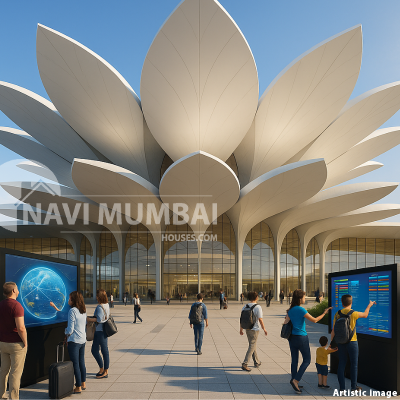
September 30, 2025: The Big Day for Navi Mumbai’s New Airport
For years, travellers in the Mumbai Metropolitan Region (MMR) have had to rely heavily on Chhatrapati Shivaji Maharaj International Airport (CSMIA). That means congestion, longer travel times, and burdened infrastructure. For people living in nodes like Ulwe, Panvel, Kharghar, etc., reaching CSMIA often involves traffic jams, long commutes, and unreliable public transport.
On the real estate side, many potential homebuyers have held back investments in peripheral areas until major transport infrastructure catches up. The uncertainty about when the new Navi Mumbai airport will deliver full connectivity has been a concern.
Because of these delays and uncertainties:
-
Travel for many remains stressful. Flights are delayed because of air traffic, and getting to the airport is a daily logistical worry.
-
Real estate in areas close to the proposed airport has remained undervalued or speculative, with lower demand due to doubts around connectivity and operations.
-
Developers hesitated launching big projects or priced them conservatively due to risk perception.
-
Local businesses that could benefit from airport-driven growth (hotels, shops, transit services) have kept plans on hold.
Now, there is good concrete news: Phase 1 of Navi Mumbai International Airport (NMIA) is set for inauguration on September 30, 2025. The operations are expected to begin in November 2025.
Here are the key features & updates, and what they mean for residents, investors, and the region:
Key Features & Facts
-
Location & Size: The airport is being built on ~1,160 hectares in Ulwe, Navi Mumbai.
-
Developers: NMIAL (Navi Mumbai International Airport Limited), a SPV by Adani Airports Holdings Limited (74%) and CIDCO (26%), is developing it.
-
Cost: Around ₹17,000 crore project cost.
-
Runways & Terminals: Two runways (each 3,700 × 60 m) planned. Phase 1 will have one terminal. Future phases will increase capacity to serve up to 9 crore passengers/year.
-
Design & Amenities: Designed by internationally acclaimed architects (Zaha Hadid). The terminal(s) will have modern features: multiple lounges, food courts, ultra-fast baggage handling with 360-degree barcode scanning, travellators, etc.
-
Sustainability & Technology: Solar energy on-site; use of electric vehicles; planned to be eco-friendly.
-
Connectivity: Multiple modes of access are planned:
-
Road: Expressways (NH 4B), Mumbai Trans Harbour Link, elevated corridors.
-
Rail: Proximity to Panvel Harbour Line, Targhar station, and potential bullet train connectivity.
-
Metro: Planned airport-express metro line (Gold Line / Metro Line 8) connecting this airport with other parts of Mumbai.
-
Water transport: Proposals for water taxi services.
-
-
Phased Rollout:
-
Phase-1: single terminal, initial operations (domestic flights), 12-hour shifts to begin, then scale-up.
-
International flights expected by ~May 2026.
-
Phase-2 and beyond: additional runway(s), more terminals, expansion of passenger capacity. Pre-development for Phase 2 to start around October 2025.
-
Real Estate & Local Impact
-
Areas close to the airport (Ulwe, Panvel, etc.) are already seeing demand rise. Locations that were once less sought-after are being revalued.
-
Developers are planning large townships and mixed-use projects near NMIA. For example, Cidco is developing a 667-acre Aerocity near the airport, which will include residential, commercial, and retail zones.
-
Improved infrastructure around the airport (roads, metro, expressways) will reduce commute times, and better amenities will follow, boosting quality of life.
-
For end users, buying properties now (before full operations) could offer benefits: lower rates, potential appreciation once the airport is fully functional.
Ask (What Should You Do / Next Steps)
If you are considering investing or moving to Navi Mumbai because of the airport, here are actionable things to do:
-
Map your priorities: proximity to airport vs price vs connectivity. Sometimes, slightly farther nodes may offer better returns.
-
Visit the Aerocity plans: understand master plans, amenities, and infrastructure promised.
-
Check developer credentials & RERA status: ensure projects near the airport are compliant and well planned.
-
Consider short vs long-term: If you will be staying many years, the infrastructure will fully mature; for short-term, more risk but possibly good gains.
-
Keep track of updates, especially when Phase-2 begins, when international operations begin, and metro and expressway completions.
Conclusion & Takeaway
The opening of Navi Mumbai International Airport (Phase-1) on September 30, 2025, marks a major turning point for Navi Mumbai’s infrastructure and real estate landscape. With modern design, strong connectivity, and phased growth, it will ease travel, boost property demand, and unlock new growth corridors. For those who plan well, it could be a transformative moment.
Visit Navimumbaihouses.com or Call Us @ 8433959100
The post From Ulwe to the Skies: Navi Mumbai International Airport’s Features & What It Means for Homebuyers appeared first on .

